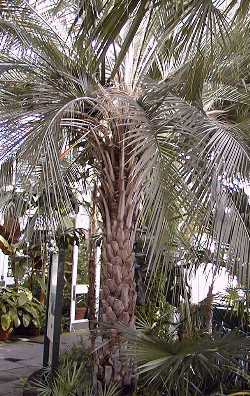Pindo Palm, Jelly Palm
Scientific Name: Butia capitata (Mart.) Becc.
Synonyms: Butia bonnettii

Size: Up to 23 feet (7 m) up to 12 feet in diameter (3.6 m)
Min. Temperature: 14°F (-10°C)
Water Requirements: Little to moderate water
Sun Requirements: Full sun to light shade
Origin: Southern Brazil, Uruguay, Argentina
Leaf: Pinnate, Glaucous green, 80-150 strong, mostly regularly arranged leaflets. Noticeably arching leaf. 4-6 foot long. coarse spiny material along the edges.
Trunk: No crownshaft, Gray with leaf scars, 18 inches in diameter (45 cm).
Flower: Large, shallowly groved, woody spathe. The very small flowers are yellow to red. Unisexual flowers appear at the end of the spring, they are in groups of three: 2 males for one female.. Flower stalk coming from among the leaves, 50-100 flowering branches.. 3 petals, 3 sepals, and 6 stamens stamens.
Fruit: Yellow to brownish red. up to 1.4 inches long (3.5 cm). Oval, sweet pulp..
Seed:
Min. Temperature: 14°F (-10°C)
Water Requirements: Little to moderate water
Sun Requirements: Full sun to light shade
Origin: Southern Brazil, Uruguay, Argentina
Leaf: Pinnate, Glaucous green, 80-150 strong, mostly regularly arranged leaflets. Noticeably arching leaf. 4-6 foot long. coarse spiny material along the edges.
Trunk: No crownshaft, Gray with leaf scars, 18 inches in diameter (45 cm).
Flower: Large, shallowly groved, woody spathe. The very small flowers are yellow to red. Unisexual flowers appear at the end of the spring, they are in groups of three: 2 males for one female.. Flower stalk coming from among the leaves, 50-100 flowering branches.. 3 petals, 3 sepals, and 6 stamens stamens.
Fruit: Yellow to brownish red. up to 1.4 inches long (3.5 cm). Oval, sweet pulp..
Seed:
Edible fruit has a sweet-tart flavor reminiscent of both apricots and a pineapple-banana mixture. It can be eaten fresh or be used to make jelly or jam. In Uruguay, it is also macerated in alcohol to make a popular liquor. The ground seed can also be roasted to make an imitation of coffee.
Butia and Syagrus are closely related genera. There is a variety of cross generic hybrids occasionally sold.
Fertilize the Pindo Palm in the spring, and in mid summer.
The spent leaves should be cut to improve its appearance.
![]()
Desert Tropicals Home Page | List of All the Plants | Check for more members of the Arecaceae family
© 1998-2020 Philippe Faucon, All Rights Reserved.